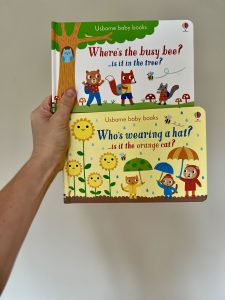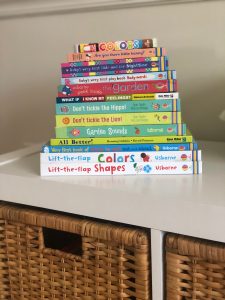Often times, we think of reading as skill that is learned and fostered in the early school aged years. However, do you know the importance of reading to infants and toddlers? Reading and storytelling provide a wide variety of benefits to infants and toddlers even before they can talk. These include exposure to sounds, words, and language as well as social emotional support, connection, and exploration. Take a look at WHY reading to babies and toddlers is so important and HOW to foster literacy skills from birth to age three.
The WHY behind Reading to Infants and Toddlers
1). Even before a child can talk, they need to hear language to support their brain development. Reading to children is a great way to expose them to new and unfamiliar words. Research has shown that babies prefer a high pitched, sing songy voice known as “parentese” or “infant-directed speech” when being spoken to. This type of vocal quality and intonation attracts their attention and makes it easier to learn new words. Not to mention, babies are comforted by the sound of their parent or caregiver’s voice. Try reading to your baby using infant-directed speech.
2). Books pair words with pictures/images. This helps babies and toddlers build connections between the words on a page, a picture, and their own world. As these connections grow, reading is a great way to strengthen word learning and expose children to new and rich vocabulary words (that we may not use in our everyday language).
3). Books foster connection. They provide an opportunity for you and your baby to attend to the same item, exchange back and forth interactions, and maybe even engage in and acknowledge some attempts at communication. Later on in toddlerhood, books open up the opportunity for children to ask questions, answer questions, and have powerful conversations. All of which are important social emotional and pre-literacy skills.
HOW to Engage in Reading with Infants and Toddlers
Book Exploration
1). Allow your child to freely explore books. This may look like picking them up, flipping the pages, looking at the pictures, and putting them back down. Babies want to explore, and this is normal early book behavior. This early exploration helps build pre-literacy concepts such as orienting books to be right side up, beginning to read on the front cover, and understanding that words are read from left to right.
2). Make books easily accessible in your home. I like to store our books in small soft baskets or on very low shelves. Display your books in different rooms and keep the location of your books consistent for your children. This will help them spontaneously and independently engage with and explore books on their own.
3). Follow your child’s lead when it comes to reading. Allow them to choose the books they are interested in. If this means they show interest in reading the same book multiple times, that is great! Repetition is a wonderful strategy for learning new words. Try to engage in reading the books they show interest in.
Book Engagement
1). Talk about the pictures on each page. Babies and toddlers do not have long attention spans. Therefore, sitting and reading all of the words on each page is not always practical. Simply talking about or naming pictures on the page allows for babies to hear and learn new words. You can point and name what you see. “I see a tree!” or “Look, a dog! Woof woof!” Or talk about the actions shown in the pictures like, “She is jumping,” or “He is swimming!”
2). Be silly and interactive when reading to infants and toddlers! This age group wants to have fun and if an activity does not catch their attention they will not be interested. Make pictures come alive by adding sound effects or actions. For example, if there is a bubble on the page you can pretend to pop it and say “pop! pop!” or say “peek a boo!” when you open a flap. Other ways to make a book come alive are: animal noises, environmental noises (car sounds “vroom!”, horn “beep! beep!”, wind “whoosh!”), exclamations “wee!” “Yuck!” “oh, no!”).

Check out some general guidelines for good books to read to infants and toddlers broken down by age.












